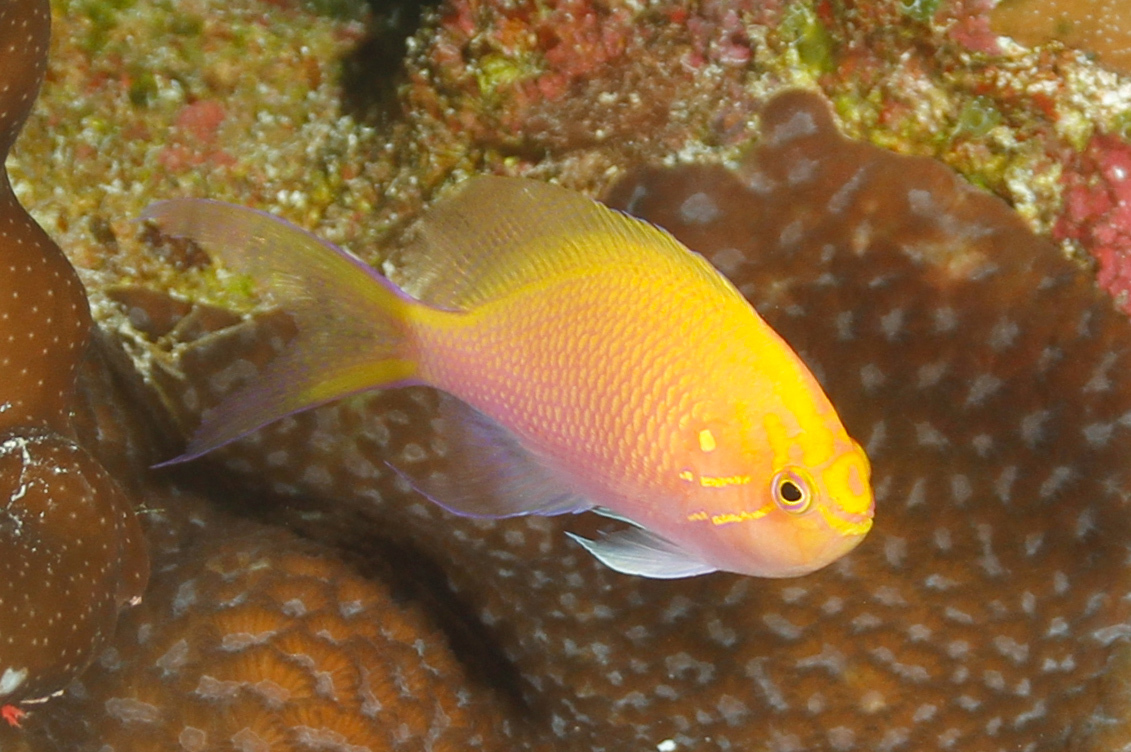Swallowtail Basslet, Serranocirrhitus latus Watanabe 1949
Other Names: Coral Perch, Fathead Anthias, Hawk Anthias, Hawkfish Anthias, Sunburst Anthias

A Swallowtail Basslet, Serranocirrhitus latus, on Bougainville Reef in the Coral Sea, July 2015. Source: Ian Shaw / iNaturalist.org. License: CC by Attribution-NonCommercial
Summary:
A deep-bodied orange-pink basslet becoming purplish-pink below, with a bright yellowish-orange mark on each scale, two yellow diagonal bands radiating from the eye, and a bright yellow spot on the gill cover.
Cite this page as:
Bray, D.J. 2024, Serranocirrhitus latus in Fishes of Australia, accessed 06 Jul 2025, https://fishesofaustralia.net.au/Home/species/1723
Swallowtail Basslet, Serranocirrhitus latus Watanabe 1949
More Info
|
Distribution |
Northern Great Barrier Reef, Queensland, and reefs in the Coral Sea. Elsewhere the species is widespread in the tropical east-Indo-west Pacific: Indonesia east to Palau, Solomon Islands and Fiji, north to southern Japan, south to Australia. Individuals or small groups are usually seen swimming upside down around cave entrances, beneath ledges and drop-offs. |
|
Features |
Dorsal fin X,18-20; Anal fin III,7; Pectoral fin 13-14, all rays unbranched; Caudal fin principal rays 15, upper and lowermost unbranched; Procurrent caudal rays, upper and lower rays 7; Scales between middle of spinous dorsal fin base and lateral line 2; Scales below lateral line to origin of anal fin 11-121/2; Circumpeduncular scales 17; Gill-rakers long and numerous, none rudimentary, longest nearly twice as long as gill filaments; Branchiostegal rays 7; Vertebrae 26. Body deep, depth 2.0 to 2.2 in SL. |
|
Colour |
Body and nape pink, each scale with a yellow spot (except ventrally); yellow spots large dorsally, leaving only a narrow rim of pink on each scale; yellow spots on side of body vertically elongate; on lower side and caudal peduncle, spots small and round. Head pink, shading to pale yellow on chin and throat, with a diagonal narrow yellow band from mouth to eye, two broader yellow bands running obliquely upward and backward from dorsal part of eye; bright yellow spot rimmed with violet on upper posterior part of opercle; prominent partially broken violet-edged yellow line running from lower edge of eye to lower pectoral base, and a second similar line above and parallel to it (originating behind centre of eye and ending above pectoral base); iris yellow with a ring of violet; basal scaled part of dorsal fin colored like body; rest of fin light yellow, the tips of interspinous membranes magenta, membrane of soft dorsal fin with narrow wavy yellow bands; postero-medial part of caudal fin colored like soft dorsal fin; lobes of fin broadly yellow on basal half, becoming finely spotted with yellow on outer part, with a pink border which is notably broader on basal part of fin; anal fin light pink on scaled basal portion, faintly yellow with indistinct yellow dots on outer unsealed part; paired fins pale pinkish. |
|
Biology |
A protogynous hermaphrodite, with females able to change sex to males. |
|
Fisheries |
This species has experienced population declines in parts of its range (not in Australia) due to its popularity as an aquarium fish. |
|
Etymology |
The specific name is from the Latin latus (= side). |
|
Species Citation |
Serranocirrhitus latus Watanabe, 1949, Bull. Biogeograph. Soc. Japan 14(4): 17. Type locality: Itoman, Okinawa Island, Ryukyu Islands, Japan. |
|
Author |
Bray, D.J. 2024 |
|
Resources |
Swallowtail Basslet, Serranocirrhitus latus Watanabe 1949
References
Allen, G.R. 1997. Marine Fishes of Tropical Australia and South-east Asia. Perth : Western Australian Museum 292 pp. 106 pls.
Allen, G.R. & Erdmann, M.V. 2012. Reef fishes of the East Indies. Perth : Tropical Reef Research 3 vols, 1260 pp.
Allen, G.R. & Starck, W.A. 1982. The anthiid fishes of the Great Barrier Reef, Australia, with the description of a new species. Revue Française d'Aquariologie et Herpétologie 9(2): 47-56 figs 1-28
Allen, G.R. & Swainston, R. 1988. The Marine Fishes of North-Western Australia. A field guide for anglers and divers. Perth, WA : Western Australian Museum vi 201 pp., 70 pls.
Kuiter, R.H. 1996. Guide to Sea Fishes of Australia. A comprehensive reference for divers and fishermen. Sydney, NSW, Australia : New Holland Publishers xvii, 434 pp.
Kuiter, R.H. & Tonozuka, T. 2001. Pictorial guide to Indonesian reef fishes. Part 1. Eels - Snappers, Muraenidae - Lutjanidae. Australia : Zoonetics pp. 1-302.
Kuiter, R.H. 2004. Basslets, Hamlets and their relatives. A comprehensive guide to selected Serranidae and Plesiopidae. Chorleywood, UK : TMC Publishing 1, 216 pp.
Randall, J.E., Allen, G.R. & Steene, R. 1990. Fishes of the Great Barrier Reef and Coral Sea. Bathurst : Crawford House Press 507 pp. figs.
Randall, J.E., Allen, G.R. & Steene, R. 1997. Fishes of the Great Barrier Reef and Coral Sea. Bathurst : Crawford House Press 557 pp. figs.
Randall, J.E. & Heemstra, P.C. 1978. Reclassification of the Japanese cirrhitid fishes Serranocirrhitus latus and Isabuna japonica to the Anthiinae. Japanese Journal of Ichthyology 25(3): 165-172 https://doi.org/10.11369/jji1950.25.165
Watanabe, M. 1949. Studies on the fishes of the Ryukyu Islands. 2. A new cirrhitoid fish. Bulletin of the Biogeographical Society of Japan 14(4): 17-20.
Whitley, G.P. 1962. A new fish from the Coral Sea (Pisces : Anthiidae). North Queensland Naturalist 30(131): 3-4 fig. 1 figs 1-3 (described as Dactylanthias mcmichaeli)
Williams, J.T., Lawrence, A. & Myers, R. 2016. Serranocirrhitus latus. The IUCN Red List of Threatened Species 2016: e.T69592071A69592864. http://dx.doi.org/10.2305/IUCN.UK.2016-3.RLTS.T69592071A69592864.en. Downloaded on 10 April 2017.









